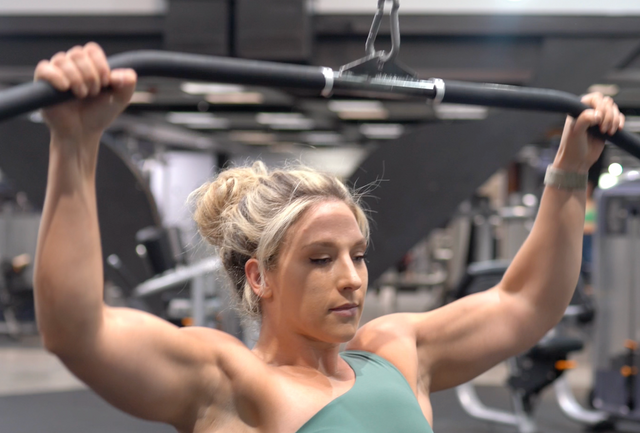Unlock Lat Gains: The Ultimate Guide to Reverse Grip Lat Pulldowns
If you're looking to carve out a powerful back and build a wider, more athletic physique, the reverse grip lat pulldown is a movement you can't afford to overlook. This variation of the classic lat pulldown offers a unique angle of pull, placing greater emphasis on the lower lats while increasing engagement through the biceps and mid-back.
Whether you're a beginner looking to improve your pull-up strength or an experienced lifter aiming to maximize lat development, the reverse grip lat pulldown is a versatile, joint-friendly option that delivers results. In this guide, we’ll break down how to perform it correctly, avoid common mistakes, explore its variations, and understand exactly why it deserves a permanent place in your training routine.
What Is the Reverse Grip Lat Pulldown?
The reverse grip lat pulldown is a compound pulling exercise performed on a lat pulldown machine using a supinated (underhand) grip, with the hands typically placed shoulder-width or slightly narrower. This setup changes the path of motion compared to traditional lat pulldowns, allowing for a deeper stretch and stronger contraction in the latissimus dorsi, particularly the lower fibers.
Because of the underhand grip, the movement also recruits the biceps brachii, brachialis, posterior deltoids, and rhomboids to a greater extent, making it not just a back builder but also a functional movement to strengthen the arms and improve posture.
"Underhand grip variations during vertical pulling exercises increase activation of the biceps brachii and lower latissimus dorsi." – Lusk et al., Journal of Strength and Conditioning Research
Benefits of Reverse Grip Lat Pulldowns
1. Lower Lat Emphasis
The supinated grip allows your elbows to travel closer to your torso, placing more tension on the lower portion of the lats—key for building back thickness and enhancing the V-taper.
2. Increased Biceps Engagement
Compared to the standard lat pulldown, this variation activates the biceps brachii and brachialis more directly. While not a replacement for arm-specific work, it’s a smart way to supplement biceps development through compound pulling.
3. Joint-Friendly Alternative
For individuals with shoulder issues, the underhand grip offers a more natural shoulder and elbow alignment, reducing internal rotation and minimizing stress on the shoulder joint.
"Supinated grips during pull-downs and chin-ups often result in more favorable joint angles for lifters with shoulder mobility restrictions." – Signorile et al., Strength and Conditioning Journal
4. Pull-Up Progression Tool
The reverse grip lat pulldown closely mimics the movement of a chin-up, making it an ideal progression tool for those working toward bodyweight pulling strength.
5. Improved Posture
Strengthening the lats, rhomboids, and lower traps contributes to scapular retraction and postural alignment, helping combat forward-leaning, rounded shoulders from prolonged sitting or screen use.
Muscles Worked in the Reverse Grip Lat Pulldown
Understanding which muscles are recruited helps you train with more intention and get better results.
-
Latissimus Dorsi (primary mover)
-
Biceps Brachii
-
Brachialis
-
Rhomboids
-
Trapezius (lower and mid)
-
Posterior Deltoids
-
Teres Major
-
Core stabilizers (for posture and control)
The reverse grip shifts load to muscles along the spine and across the arms, making it a full upper-body pulling movement that builds size, stability, and strength.
How to Perform the Reverse Grip Lat Pulldown (Step-by-Step)
-
Set Up
Sit down on a lat pulldown machine and secure your thighs under the pads. Choose a straight bar or EZ-bar attachment. Use a supinated (underhand) grip, hands placed shoulder-width apart or slightly narrower. -
Engage Your Core and Position Your Body
Sit tall with your chest up and spine neutral. Lean back just slightly to allow full lat contraction. Brace your core to avoid arching or excessive leaning. -
Initiate the Pull
Pull the bar down toward your upper chest by driving your elbows down and back. Keep your elbows close to your sides throughout the movement. -
Squeeze and Control
At the bottom, pause and squeeze your lats for 1–2 seconds before slowly returning the bar to the top with control. Allow a slight stretch at the top without fully locking out your elbows or losing form.
Common Mistakes to Avoid
-
Leaning Too Far Back: Turning this into a row defeats the purpose and takes tension off the lats.
-
Using Momentum: Jerking the weight down shifts stress to the joints and reduces muscle activation.
-
Flared Elbows: This minimizes lat recruitment and increases risk of shoulder strain.
-
Incomplete Range of Motion: Not pulling all the way to the chest or failing to stretch at the top limits the exercise’s effectiveness.
Reverse Grip Lat Pulldown Variations
1. EZ-Bar Reverse Grip Pulldown
Allows for a more comfortable wrist position, especially for those with limited wrist mobility.
2. Unilateral Reverse Grip Pulldown (Single Arm)
Helps address muscular imbalances and improves mind-muscle connection on each side.
3. Drop Sets
Perform a heavy set, then immediately reduce the weight and continue. Great for hypertrophy and volume training.
4. Slow Eccentric Reps
Focus on lowering the bar slowly (3–4 seconds) to increase time under tension and improve control.
"Manipulating tempo during resistance exercises enhances mechanical tension and metabolic stress, both critical for hypertrophy." – Schoenfeld, Journal of Strength and Conditioning Research
Programming: How to Use It in Your Training
The reverse grip lat pulldown can serve as:
-
A primary vertical pull for beginners building lat strength
-
An accessory lift to chin-ups or pull-ups
-
A hypertrophy tool when performed for high reps and strict form
Sample Programming
| Goal | Sets | Reps | Rest |
|---|---|---|---|
| Muscle Growth (Hypertrophy) | 3–4 | 8–12 | 60–90 sec |
| Strength | 4–5 | 4–6 | 2–3 min |
| Endurance/Conditioning | 2–3 | 15–20 | 30–60 sec |
Incorporate this movement 1–2 times per week, especially on pull-focused or back + biceps days.
Complementary Exercises for a Complete Pulling Routine
To round out your back training and avoid muscular imbalances, combine the reverse grip lat pulldown with:
-
Neutral Grip Pull-Ups – Vertical pulling with joint-friendly alignment
-
Barbell Rows – Builds thickness across the mid- and lower back
-
Face Pulls – Strengthens rear delts and improves scapular mechanics
-
Dumbbell Pullovers – Enhances lat length and chest expansion
-
Chin-Ups – A progression from the reverse grip pulldown using bodyweight resistance
Conclusion: Why You Should Be Doing Reverse Grip Lat Pulldowns
The reverse grip lat pulldown is more than just a back exercise—it’s a strategic tool for building a wide, powerful, and functional upper body. Its unique grip shifts emphasis to the lower lats and biceps, making it a perfect complement to other pulling movements. It’s also safer for the joints, effective for hypertrophy, and a great regression for chin-up progressions.
Whether you're chasing muscle growth, improving your posture, or refining your physique, this movement belongs in your program. Train it with intention, avoid the common pitfalls, and keep progressing with better technique and smarter programming.
Find similar articles:
Fitness






